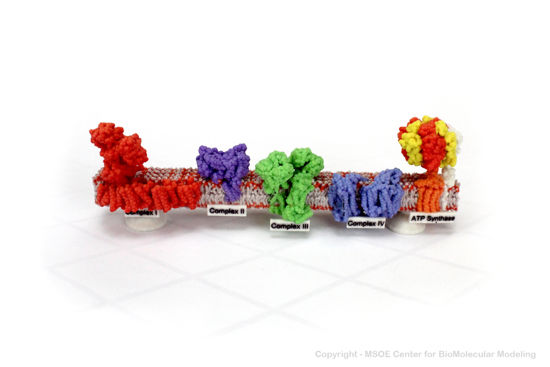ATPase
From Proteopedia
(Difference between revisions)
| Line 14: | Line 14: | ||
* '''MipZ''' is an ATPase which forms a complex with the chromosome partitioning protein ParB and is responsible for the regulation of FtsZ ring formation.<br /> | * '''MipZ''' is an ATPase which forms a complex with the chromosome partitioning protein ParB and is responsible for the regulation of FtsZ ring formation.<br /> | ||
ATPase domains include metal-binding domain (MBD) and nucleotide-binding domain (NBD). For more details see:<br /> | ATPase domains include metal-binding domain (MBD) and nucleotide-binding domain (NBD). For more details see:<br /> | ||
| + | * '''ATPase RavA''' participates in the pathway which response to ahminoglycosides under anaerobic conditions and cell membrane regulation<ref>PMID:36127320</ref>. <br /> | ||
*Cu transporting ATPase are in [[P(1B)-Type Cu(I) Transporting ATPases ATP7A and ATP7B]].<br /> | *Cu transporting ATPase are in [[P(1B)-Type Cu(I) Transporting ATPases ATP7A and ATP7B]].<br /> | ||
*Na/K transporting ATPase are in [[Sodium-Potassium ATPase]].<br /> | *Na/K transporting ATPase are in [[Sodium-Potassium ATPase]].<br /> | ||
Revision as of 10:45, 28 May 2024
| |||||||||||
Contents |
3D Printed Physical Model of ATP Synthase
Shown below is a 3D printed physical model of the Respiration Electron Transport Chain. Complex I is colored red, complex II is purple, complex III is green, complex IV is blue and the atp synthase protein is colored orange, yellow and red.

The MSOE Center for BioMolecular Modeling
The MSOE Center for BioMolecular Modeling uses 3D printing technology to create physical models of protein and molecular structures, making the invisible molecular world more tangible and comprehensible. To view more protein structure models, visit our Model Gallery.
3D Structures of ATPase
References
- ↑ Rappas M, Niwa H, Zhang X. Mechanisms of ATPases--a multi-disciplinary approach. Curr Protein Pept Sci. 2004 Apr;5(2):89-105. doi: 10.2174/1389203043486874. PMID:15078220 doi:http://dx.doi.org/10.2174/1389203043486874
- ↑ Neupane P, Bhuju S, Thapa N, Bhattarai HK. ATP Synthase: Structure, Function and Inhibition. Biomol Concepts. 2019 Mar 7;10(1):1-10. doi: 10.1515/bmc-2019-0001. PMID:30888962 doi:http://dx.doi.org/10.1515/bmc-2019-0001
- ↑ Abrahams JP, Leslie AG, Lutter R, Walker JE. Structure at 2.8 A resolution of F1-ATPase from bovine heart mitochondria. Nature. 1994 Aug 25;370(6491):621-8. PMID:8065448 doi:http://dx.doi.org/10.1038/370621a0
- ↑ Dupont C, Viljoen A, Thomas S, Roquet-Banères F, Herrmann JL, Pethe K, Kremer L. Bedaquiline Inhibits the ATP Synthase in Mycobacterium abscessus and Is Effective in Infected Zebrafish. Antimicrob Agents Chemother. 2017 Oct 24;61(11):e01225-17. PMID:28807917 doi:10.1128/AAC.01225-17
- ↑ Chan H, Babayan V, Blyumin E, Gandhi C, Hak K, Harake D, Kumar K, Lee P, Li TT, Liu HY, Lo TC, Meyer CJ, Stanford S, Zamora KS, Saier MH Jr. The p-type ATPase superfamily. J Mol Microbiol Biotechnol. 2010;19(1-2):5-104. doi: 10.1159/000319588. Epub 2010, Oct 20. PMID:20962537 doi:http://dx.doi.org/10.1159/000319588
- ↑ Plesner L. Ecto-ATPases: identities and functions. Int Rev Cytol. 1995;158:141-214. doi: 10.1016/s0074-7696(08)62487-0. PMID:7721538 doi:http://dx.doi.org/10.1016/s0074-7696(08)62487-0
- ↑ Felix J, Bumba L, Liesche C, Fraudeau A, Rébeillé F, El Khoury JY, Huard K, Gallet B, Moriscot C, Kleman JP, Duhoo Y, Jessop M, Kandiah E, Barras F, Jouhet J, Gutsche I. The AAA+ ATPase RavA and its binding partner ViaA modulate E. coli aminoglycoside sensitivity through interaction with the inner membrane. Nat Commun. 2022 Sep 20;13(1):5502. PMID:36127320 doi:10.1038/s41467-022-32992-9
Proteopedia Page Contributors and Editors (what is this?)
Michal Harel, Wayne Decatur, Alexander Berchansky, Mark Hoelzer, Marius Mihasan, Karsten Theis, Jaime Prilusky

